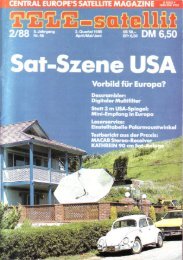Bestellen Sie diesen Satelliten- Newsletter! - TELE-satellite ...
Bestellen Sie diesen Satelliten- Newsletter! - TELE-satellite ...
Bestellen Sie diesen Satelliten- Newsletter! - TELE-satellite ...
Create successful ePaper yourself
Turn your PDF publications into a flip-book with our unique Google optimized e-Paper software.
176<br />
Very imposing structure leaning against the pergola ready for the lift.<br />
This shows the relationship of all the dishes to each other. The only one eclipsed at any time is the<br />
small offset dish underneath the 2.4 metre dish. Otherwise all dishes can see all <strong>satellite</strong>s together all<br />
the time.<br />
actually tapered up and made a sturdy tower.<br />
Mid-November I dug the hole to a depth of<br />
2.4 metres and 50 cm square. Then a big rain<br />
storm came and filled the hole with, dare I<br />
say it... rainwater, what else.<br />
The statistics so far: A dish twice the diameter<br />
of the Perfect 10, four times the area and<br />
so far eight times the trouble. Besides, its still<br />
in four cardboard boxes. The adventure does<br />
not end here. About this time I went to New<br />
Zealand for a rest away from <strong>satellite</strong> tv.<br />
Have you ever spent Christmas in another<br />
country raced around sight seeing and came<br />
home relaxed? No I didn’t either. The dish is<br />
still in the boxes. The hole has now caved in<br />
a bit and is only one metre deep. It still has<br />
water in it. Each day I would dig out a wheel<br />
barrow of dirt, put it in boxes and take it to<br />
work and dump it on the contractor’s site.<br />
They did not mind as they were putting cubic<br />
metres of earth there every day.<br />
At one time the pile of uncompressed dirt<br />
at my place was a metre high, and this needed<br />
to be removed constantly. The hole was<br />
eventually dug out to a bit over two metres<br />
deep and 600 x 800 mm.<br />
Remember those two pieces of angle iron?<br />
They were too long to negotiate down the<br />
side of the house so they were put through<br />
the front window and marched through the<br />
house and out the back door. They looked<br />
really impressive lying on the lounge room<br />
carpet and disappearing into the dining<br />
room. Flattened the pile on the carpet while<br />
they were lying there though. This problem<br />
was fixed by shampooing the carpet.<br />
Now to turn these cardboard boxes into a<br />
wok. Remember the pole? It is mild steel and<br />
has surface rust. A good rust inhibitor on the<br />
inside and outside is needed. The pole needs<br />
to last at least five years or ten and usually<br />
more. How do you paint inside a 5-inch by<br />
3 metre pole? Anybody into ceramics and<br />
pottery do it all the time. Put one end of the<br />
pole in a shallow tray, raise the other end<br />
and pour that tin of expensive rust inhibitor<br />
down the centre, rotating the pole as you<br />
do it. It need not be messy. Then get the<br />
paint out of the tray pour it back in the tin<br />
and start again. Get a good coating on the<br />
inside, especially if you intend filling it with<br />
concrete. Paint the outside with a brush and<br />
when it is all dry give it a few liberal coats<br />
of your best all weather paint. I used a nice<br />
black gloss.<br />
One thing I did was to read the construction<br />
manual over and over again. I carefully<br />
opened all the boxes and laid the parts out<br />
and counted them. Most important is to<br />
count the number of nuts and bolts and<br />
ensure that you identify each batch correctly.<br />
In my case I had to bolt 18 ribs to a centre<br />
hub with bolts of two different sizes. Thirty<br />
six in all. With this done, place it on the<br />
mounting ring and bolt the 18 supports to<br />
it. Another 36 nuts and bolts of another size.<br />
While doing all this do not tighten all the nuts<br />
up tight yet. You need a little flexibility in getting<br />
the dish true.<br />
An besides, if you don’t have anyone<br />
to help you put this together you have to<br />
encourage your wife, girlfriend, whatever to<br />
become interested in <strong>satellite</strong> TV. You need<br />
someone to get under the dish to hold the<br />
bolt heads while you tighten the nuts.<br />
When it’s time to slide the mesh panels in<br />
you may find they are a difficult fit. What<br />
happens here is the panels are cut using<br />
a guillotine, as the blade comes down it<br />
crushes the mesh and bends the edges down<br />
slightly, these need to be straightened out<br />
by placing the edges on a flat piece of steel<br />
and lightly tapping with a hammer or a small<br />
steel block with a flat surface. You are then<br />
left with a straight panel instead of one that<br />
is turned slightly at the edges. They should<br />
now slide in easily. When installing panels<br />
in a large dish the ribs need to be supported<br />
with a rope around the perimeter in order to<br />
bring the dish to its correct shape otherwise<br />
the panels will just drop out. As you insert<br />
panels attach the outer ring and work your<br />
way around the dish until you get to the last<br />
set. Remember you have not tightened all<br />
the bolts up yet. One of the reasons here is<br />
that you need to draw the dish edges up so<br />
as the last piece of the rim will fit, when it is<br />
all secured, it is time to string the dish.<br />
With the dish still sitting on its mounting<br />
ring, check the diameter of the dish from<br />
three or four opposing sides, that is two measurements<br />
90° opposed to each other. These<br />
should be the same but if one measurement<br />
is larger than the other get your helper and<br />
lift the rim on opposite sides at the larger<br />
distance. As the dish is still flexible this has<br />
the effect of narrowing this measurement<br />
and increasing the other one. Eventually you<br />
will get it round. While making this adjustment<br />
start tightening all those loose or just<br />
nipped up bolts. The dish now starts to lose<br />
its flexibility and become rigid. It is string<br />
time now, get a ball of string and stretch it<br />
across the centre of the dish over the edge of<br />
the rim at 90 degrees and also make a star or<br />
<strong>TELE</strong>-<strong>satellite</strong> International











